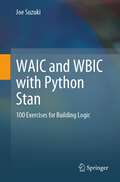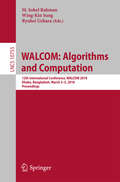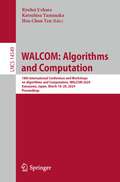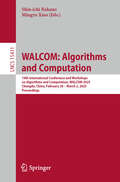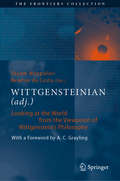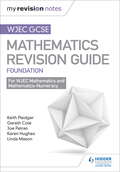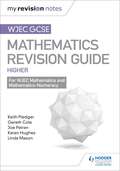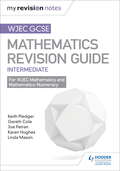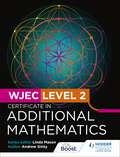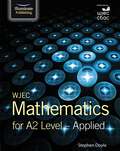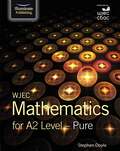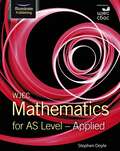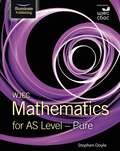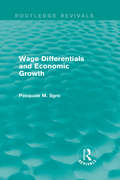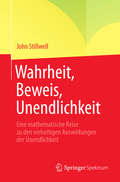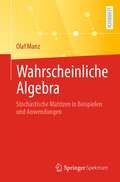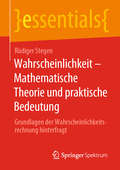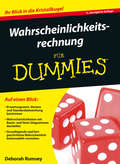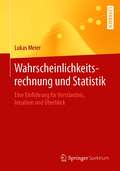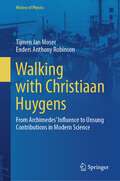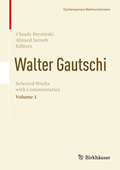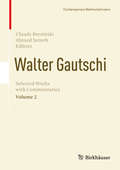- Table View
- List View
WAIC and WBIC with Python Stan: 100 Exercises for Building Logic
by Joe SuzukiMaster the art of machine learning and data science by diving into the essence of mathematical logic with this comprehensive textbook. This book focuses on the widely applicable information criterion (WAIC), also described as the Watanabe-Akaike information criterion, and the widely applicable Bayesian information criterion (WBIC), also described as the Watanabe Bayesian information criterion. The book expertly guides you through relevant mathematical problems while also providing hands-on experience with programming in Python and Stan. Whether you’re a data scientist looking to refine your model selection process or a researcher who wants to explore the latest developments in Bayesian statistics, this accessible guide will give you a firm grasp of Watanabe Bayesian Theory.The key features of this indispensable book include:A clear and self-contained writing style, ensuring ease of understanding for readers at various levels of expertise.100 carefully selected exercises accompanied by solutions in the main text, enabling readers to effectively gauge their progress and comprehension.A comprehensive guide to Sumio Watanabe’s groundbreaking Bayes theory, demystifying a subject once considered too challenging even for seasoned statisticians.Detailed source programs and Stan codes that will enhance readers’ grasp of the mathematical concepts presented.A streamlined approach to algebraic geometry topics in Chapter 6, making Bayes theory more accessible and less daunting.Embark on your machine learning and data science journey with this essential textbook and unlock the full potential of WAIC and WBIC today!
WAIC and WBIC with R Stan: 100 Exercises for Building Logic
by Joe SuzukiMaster the art of machine learning and data science by diving into the essence of mathematical logic with this comprehensive textbook. This book focuses on the widely applicable information criterion (WAIC), also described as the Watanabe-Akaike information criterion, and the widely applicable Bayesian information criterion (WBIC), also described as the Watanabe Bayesian information criterion. This book expertly guides you through relevant mathematical problems while also providing hands-on experience with programming in R and Stan. Whether you’re a data scientist looking to refine your model selection process or a researcher who wants to explore the latest developments in Bayesian statistics, this accessible guide will give you a firm grasp of Watanabe Bayesian Theory.The key features of this indispensable book include:A clear and self-contained writing style, ensuring ease of understanding for readers at various levels of expertise.100 carefully selected exercises accompanied by solutions in the main text, enabling readers to effectively gauge their progress and comprehension.A comprehensive guide to Sumio Watanabe’s groundbreaking Bayes theory, demystifying a subject once considered too challenging even for seasoned statisticians.Detailed source programs and Stan codes that will enhance readers’ grasp of the mathematical concepts presented.A streamlined approach to algebraic geometry topics in Chapter 6, making Bayes theory more accessible and less daunting.Embark on your machine learning and data science journey with this essential textbook and unlock the full potential of WAIC and WBIC today!
WALCOM: 12th International Conference, WALCOM 2018, Dhaka, Bangladesh, March 3-5, 2018, Proceedings (Lecture Notes in Computer Science #10755)
by M. Sohel Rahman Wing-Kin Sung Ryuhei UeharaThis book constitutes the proceedings of the 12th International Workshop on Algorithms and Computation, WALCOM 2018, held in Dhaka, Bangladesh, in March 2018.The 22 full papers presented were carefully reviewed and selected from 50 submissions. The papers cover diverse areas of algorithms and computation, such as approximation algorithms, computational geometry, combinatorial algorithms, computational biology, computational complexity, data structures, graph and network algorithms, and online algorithms.
WALCOM: 18th International Conference and Workshops on Algorithms and Computation, WALCOM 2024, Kanazawa, Japan, March 18–20, 2024, Proceedings (Lecture Notes in Computer Science #14549)
by Hsu-Chun Yen Ryuhei Uehara Katsuhisa YamanakaThis book constitutes the refereed proceedings of the 18th International Conference and Workshops on Algorithms and Computation, WALCOM 2024, held in Kanazawa, Japan, during March 18–20, 2024. The 28 full papers presented in this book, together with two extended abstracts of invited talks, were carefully reviewed and selected from 80 submissions. They cover diverse areas of algorithms and computation, that is, approximation algorithms, algorithmic graph theory and combinatorics, combinatorial algorithms, combinatorial optimization, computational biology, combinatorial reconfiguration, computational complexity, computational geometry, discrete geometry, data structures, experimental algorithm methodologies, graph algorithms, graph drawing, parallel and distributed algorithms, parameterized algorithms, parameterized complexity, network optimization, online algorithms, randomized algorithms, and string algorithms.
WALCOM: 19th International Conference and Workshops on Algorithms and Computation, WALCOM 2025, Chengdu, China, February 28 – March 2, 2025, Proceedings (Lecture Notes in Computer Science #15411)
by Shin-Ichi Nakano Mingyu XiaoThis book LNCS 15411 constitutes the refereed proceedings of the 19th International Conference and Workshops on Algorithms and Computation, WALCOM 2025, held in Chengdu, China, during February 28 – March 2, 2025. The 26 full papers were carefully reviewed and selected from 68 submissions. WALCOM 2025 covered a wide range of topics, including approximation algorithms, algorithmic graph theory and combinatorics, algorithmic and combinatorial aspects of logic, combinatorial algorithms, combinatorial optimization, combinatorial reconfiguration, computational biology, computational complexity, computational geometry, discrete geometry, data structures, experimental algorithm methodologies, graph algorithms, graph drawing, parallel and distributed algorithms, parameterized algorithms and complexity, network optimization, online algorithms, randomized algorithms, and string algorithms.
WITTGENSTEINIAN: Looking at the World from the Viewpoint of Wittgenstein's Philosophy (The Frontiers Collection)
by Shyam Wuppuluri Newton Da Costa“Tell me," Wittgenstein once asked a friend, "why do people always say, it was natural for man to assume that the sun went round the earth rather than that the earth was rotating?" His friend replied, "Well, obviously because it just looks as though the Sun is going round the Earth." Wittgenstein replied, "Well, what would it have looked like if it had looked as though the Earth was rotating?” What would it have looked like if we looked at all sciences from the viewpoint of Wittgenstein’s philosophy? Wittgenstein is undoubtedly one of the most influential philosophers of the twentieth century. His complex body of work has been analysed by numerous scholars, from mathematicians and physicists, to philosophers, linguists, and beyond. This volume brings together some of his central perspectives as applied to the modern sciences and studies the influence they may have on the thought processes underlying science and on the world view it engenders. The contributions stem from leading scholars in philosophy, mathematics, physics, economics, psychology and human sciences; all of them have written in an accessible style that demands little specialist knowledge, whilst clearly portraying and discussing the deep issues at hand.
WJEC GCSE Maths Foundation: Mastering Mathematics Revision Guide
by Karen Hughes Linda Mason Gareth Cole Keith Pledger Joe PetranExam Board: WJECLevel: GCSESubject: MathematicsFirst Teaching: September 2015First Exam: June 2017Maximise your students' grade potential with a step-by-step approach that builds confidence through topic summaries, worked examples and exam style questions- Identify areas of improvement to focus on through diagnostic tests for each topic.- Develop exam skills and techniques with skills-focused exam-style questions and exam advice on common pitfalls.- Build understanding and confidence with clear explanations of each topic covering all the key information needed to succeed.- Consolidate revision with 'two weeks to go' summaries for each topic.
WJEC GCSE Maths Higher: Mastering Mathematics Revision Guide
by Gareth Cole Keith Pledger Joe PetranExam Board: WJECLevel: GCSESubject: MathematicsFirst Teaching: September 2015First Exam: June 2017Maximise your students' grade potential with a step-by-step approach that builds confidence through topic summaries, worked examples and exam style questions.- Identify areas of improvement to focus on through diagnostic tests for each topic.- Develop exam skills and techniques with skills-focused exam-style questions and exam advice on common pitfalls.- Build understanding and confidence with clear explanations of each topic covering all the key information needed to succeed.- Consolidate revision with 'two weeks to go' summaries for each topic.
WJEC GCSE Maths Higher: Mastering Mathematics Revision Guide
by Gareth Cole Keith Pledger Joe PetranExam Board: WJECLevel: GCSESubject: MathematicsFirst Teaching: September 2015First Exam: June 2017Maximise your students' grade potential with a step-by-step approach that builds confidence through topic summaries, worked examples and exam style questions.- Identify areas of improvement to focus on through diagnostic tests for each topic.- Develop exam skills and techniques with skills-focused exam-style questions and exam advice on common pitfalls.- Build understanding and confidence with clear explanations of each topic covering all the key information needed to succeed.- Consolidate revision with 'two weeks to go' summaries for each topic.
WJEC GCSE Maths Intermediate: Revision Guide
by Gareth Cole Keith Pledger Joe PetranExam Board: WJECLevel: GCSESubject: MathematicsFirst Teaching: September 2015First Exam: June 2017Maximise your students' grade potential with a step-by-step approach that builds confidence through topic summaries, worked examples and exam-style questions; developed specifically for the new Mathematics specifications, with leading Assessment Consultant Keith Pledger.- Identify areas of improvement to focus on through diagnostic tests for each topic.- Develop exam skills and techniques with skills-focused exam-style questions and exam advice on common pitfalls.- Build understanding and confidence with clear explanations of each topic covering all the key information needed to succeed.- Consolidate revision with 'two weeks to go' summaries for each topic.
WJEC GCSE Maths Intermediate: Revision Guide
by Gareth Cole Keith Pledger Joe PetranExam Board: WJECLevel: GCSESubject: MathematicsFirst Teaching: September 2015First Exam: June 2017Maximise your students' grade potential with a step-by-step approach that builds confidence through topic summaries, worked examples and exam-style questions; developed specifically for the new Mathematics specifications, with leading Assessment Consultant Keith Pledger.- Identify areas of improvement to focus on through diagnostic tests for each topic.- Develop exam skills and techniques with skills-focused exam-style questions and exam advice on common pitfalls.- Build understanding and confidence with clear explanations of each topic covering all the key information needed to succeed.- Consolidate revision with 'two weeks to go' summaries for each topic.
WJEC Level 2 Certificate in Additional Mathematics
by Andrew GintyStretch and challenge students with this introduction to higher level mathematics. Including plenty of practice activities and worked examples, this book bridges the gap from GCSE to A-level, building students' reasoning and problem-solving skills in preparation for the next step.- Develop understanding of mathematics with discussion points, thought-provoking activities and rigorous exercise questions- Build confidence with notes on how prior knowledge can be applied to tackle new concepts- Develop problem-solving skills with step-by-step worked examples and practice questions- Be aware of potential misunderstandings with common pitfalls noted throughout the text- Check progress using a checklist of key points and learning outcomes at the end of each chapter- Help students to achieve their potential with two practice papers at the end of the bookAnswers to exercise questions are at the back of the book and online, alongside full worked solutions and mark schemes for the practice papers
WJEC Mathematics for A2 Level: Pure And Applied Revision Guide
by Stephen DoyleWritten by bestselling author Stephen Doyle, this student book will engage and motivate you throughout the course. // Endorsed by WJEC offering high quality support you can trust. // Thorough coverage of all the topics in the A2 Level Applied specification. // Extra support for the problem solving and unstructured questions in the specification. // Plenty of examples with worked answers throughout to enable you to check your understanding as you progress through the course. // Answers to questions are provided in order to check your work.
WJEC Mathematics for A2 Level: Pure And Applied Revision Guide
by Stephen DoyleWritten by bestselling author Stephen Doyle, this student book will engage and motivate you throughout the course. // Endorsed by WJEC offering high quality support you can trust. // Thorough coverage of all the topics in the A2 Level Pure specification. // Extra support for the problem solving and unstructured questions in the specification. // Plenty of examples with worked answers throughout to enable you to check your understanding as you progress through the course. // Answers to questions are provided in order to check your work.
WJEC Mathematics for AS Level: Applied
by Stephen DoyleWritten by bestselling author Stephen Doyle, this student book will engage and motivate you throughout the course. // Endorsed by WJEC offering high quality support you can trust. // Thorough coverage of all the topics in the AS Level Applied specification. // Extra support for the problem solving and unstructured questions in the specification. // Plenty of examples with worked answers throughout to enable you to check your understanding as you progress through the course. // Answers to questions are provided in order to check your work.
WJEC Mathematics for AS Level: Pure & Applied: Revision Guide
by Stephen DoyleWritten by bestselling author Stephen Doyle, this student book will engage and motivate you throughout the course. // Endorsed by WJEC offering high quality support you can trust. // Thorough coverage of all the topics in the AS Level Pure specification. // Extra support for the problem solving and unstructured questions in the specification. // Plenty of examples with worked answers throughout to enable you to check your understanding as you progress through the course. // Answers to questions are provided in order to check your work.
Wage Differentials and Economic Growth (Routledge Revivals)
by Pasquale SgroThis book, which was first published in 1980, is concerned with one particular branch of growth theory, namely descriptive growth theory. It is typically assumed in growth theory that both the factors and goods market are perfectly competitive. In particular this implies amongst other things that the reward to each factor is identical in each sector of the economy. In this book the assumption of identical factor rewards is relaxed and the implications of an intersectoral wage differential for economic growth are analysed. There is also some discussion on the short-term and long-run effects of minimum wage legislation on growth. This book will serve as key reading for students of economics.
Wahrheit, Beweis, Unendlichkeit: Eine mathematische Reise zu den vielseitigen Auswirkungen der Unendlichkeit
by John StillwellIn dem Buch erkundet der preisgekrönte Autor John Stillwell die Konsequenzen, die sich ergeben, wenn man die Unendlichkeit akzeptiert, und diese Konsequenzen sind vielseitig und überraschend. Der Leser benötigt nur wenig über die Schulmathematik hinausgehendes Hintergrundwissen; es reicht die Bereitschaft, sich mit ungewohnten Ideen auseinanderzusetzen. Stillwell führt den Leser sanft in die technischen Details von Mengenlehre und Logik ein, indem jedes Kapitel einem einzigen Gedankengang folgt, der mit einer natürlichen mathematischen Frage beginnt und dann anhand einer Abfolge von historischen Antworten nachvollzogen wird. Auf diese Weise zeigt der Autor, wie jede Antwort ihrerseits zu neuen Fragen führt, aus denen wiederum neue Begriffe und Sätze entstehen.Jedes Kapitel endet mit einem Abschnitt „Historischer Hintergrund“, der das Thema in den größeren Zusammenhang der Mathematik und ihrer Geschichte einordnet.
Wahrscheinliche Algebra: Stochastische Matrizen in Beispielen und Anwendungen
by Olaf ManzDieses kompakte Buch gibt eine verständliche, anwendungsnahe Einführung in stochastische Matrizen anhand von Beispielen aus dem Alltag. Zur Einführung untersuchen wir zunächst die Verbreitung von Gerüchten. Anschließend setzen wir Mäuse in Irrgärten aus und verstecken darin Mausefallen. Als Pendant gehen wir in freier Wildbahn nach Füchsen auf die Jagd. Wir kümmern uns auch um Themen des alltäglichen Lebens wie die Gesundheit, die Vererbung, die Ausbildung, das Konsumverhalten und den Sport. Wir verfolgen den Ruin von Glücksspielern, schauen uns aber auch das faire Mischen von Spielkarten näher an. Abschließend sind wir mit Jim Knopf zu einer Reise durch Lummerland verabredet. Dabei beobachten wir die Warteschlangen, die sich vor Lukas, dem Lokomotivführer und seiner Lok Emma bilden. Wir kümmern uns auch um die Reparaturplanung der Loks und werfen hierzu einen Blick in Emmas Lokschuppen und Ersatzteillager. Das Buch eignet sich durch den lockeren Stil insbesondere auch für Nichtmathematiker.
Wahrscheinlichkeit – Mathematische Theorie und praktische Bedeutung: Grundlagen der Wahrscheinlichkeitsrechnung hinterfragt (essentials)
by Rüdiger StegenIn diesem Buch werden grundlegende Begriffe und Methoden der Wahrscheinlichkeitsrechnung kritisch hinterfragt. Zunächst wird geklärt, welche Beziehung zwischen den Wahrscheinlichkeiten in der Umgangssprache, der angewandten Stochastik und den Kolmogoroffschen Axiomen besteht. Dann werden typische Aufgaben mit Hilfe des Urnenmodells gelöst. Schließlich werden bedingte Wahrscheinlichkeiten, das (empirische) Gesetz der großen Zahlen sowie Kombinationen mehrerer Wahrscheinlichkeiten eines Ereignisses behandelt.
Wahrscheinlichkeitsrechnung für Dummies (Für Dummies)
by Deborah J. RumseyDie Wahrscheinlichkeitsrechnung wird in der Schule oft nur beiläufig behandelt, dabei handelt es sich um ein besonders spannendes und alltagstaugliches Teilgebiet der Mathematik. Für alle, die über dieses Thema noch etwas mehr erfahren wollen oder müssen, erklärt Deborah Rumsey verständlich und mit Humor, was sie unbedingt wissen sollten. Egal ob Kontingenztabelle, zentraler Grenzwertsatz, Stichproben-, Binomial- oder Poissonverteilung, in diesem Buch lernen Sie, was es ist und wie Sie es anwenden. Zu jedem Kapitel finden Sie online eine Übungsaufgabe samt Lösung, um das Gelernte zu festigen. Auch Tipps zu praktischen Anwendungen - ob bei der Arbeit oder am Pokertisch - kommen nicht zu kurz. So finden Sie in diesem Buch alles, was Sie über Wahrscheinlichkeitsrechnung unbedingt wissen sollten.
Wahrscheinlichkeitsrechnung und Statistik: Eine Einführung für Verständnis, Intuition und Überblick
by Lukas MeierDieses Lehrbuch führt in die zentralen Begriffe und Konzepte der Wahrscheinlichkeitsrechnung, der beschreibenden sowie der schließenden Statistik ein. Der Fokus liegt dabei auf einem intuitiven Verständnis der grundlegenden Konzepte, Zusammenhänge und Methoden. Trotzdem wird der Stoff mathematisch präzise präsentiert. Innerhalb jedes Kapitels finden Sie verschiedene didaktische Elemente, die Ihnen den Zugang und das Verständnis, aber auch die Orientierung deutlich erleichtern:Kurzübersicht der wichtigsten Begriffe am KapitelanfangAnschauliche Erklärungen und BeispieleZentrale Sachverhalte und DefinitionenWarnungen vor häufigen MissverständnissenSeparate Textabschnitte zur IntuitionGrafische oder tabellarische Übersichten am KapitelendeAm Ende der meisten Abschnitte finden Sie kurze Lernkontrollen – hier können Sie Ihr Wissen überprüfen, indem Sie verschiedene Aussagen als wahr oder falsch einordnen. Die Lösungen finden Sie im Anhang, je nach Schwierigkeitsgrad mit kurzem Lösungsweg. Am Ende der Kapitel finden Sie außerdem Verständnisfragen, die noch einmal die wichtigsten Inhalte abfragen und so Ihren Lernfortschritt zeigen.
Walking with Christiaan Huygens: From Archimedes' Influence to Unsung Contributions in Modern Science (History of Physics)
by Enders Anthony Robinson Tijmen Jan MoserDutch scientist Christiaan Huygens (1629-1695) left an indelible mark on the fields of mathematics, physics, astronomy, and geophysics. Despite his groundbreaking contributions, history has often overlooked his pivotal role. While two of the most famous achievements in physics are Newton’s theory of gravity and Einstein’s general theory of relativity, less well-known is that Huygens provided central elements to these theories. This book stands to correct that deficit. For example, we show how Huygens used symmetry arguments to derive conservation laws for momentum and for energy, and what Einstein later called the principle of equivalence to derive the formula for centrifugal force. In 1689, Huygens visited Newton. Together, they walked the streets of London. Newton had recently finished his masterpiece, Principia, expounding his laws of motion and the law of universal gravitation. Huygens had essentially completed his life’s work by then, building on Archimedes, Leonardo da Vinci, Galileo, Descartes, Fermat, Pascal and his own ingenuity. He had established fame as an instrument maker (telescope, pendulum clock, planetarium). He had invented the 31 tone system. He had pioneered the first principles of remote sensing. He had discovered the rings of Saturn. He had formulated the wave theory of light. What would walking with Christiaan reveal? This book gives the result in nine chapters, namely: spontaneous order, the speed of light, Huygens’ principle, the telescope, the pendulum clock, Huygens-Fresnel principle, special relativity, centrifugal force, and curvature. In addition, there is a chapter titled What Huygens could have written on diffraction, and a chapter titled Huygens and Geophysics. Mentally walking with Christiaan, browsing his collected works — a true treasure trove for puzzle enthusiasts — and rethinking his ideas creates a vivid impression of scientific life in the 17th century, an appreciation that it is remarkably similar to ours, and an understanding of Huygens' significant and lasting contributions to science.
Walter Gautschi, Volume 1
by Claude Brezinski Ahmed SamehWalter Gautschi has written extensively on topics ranging from special functions, quadrature and orthogonal polynomials to difference and differential equations, software implementations, and the history of mathematics. He is world renowned for his pioneering work in numerical analysis and constructive orthogonal polynomials, including a definitive textbook in the former, and a monograph in the latter area.<P><P> This three-volume set, Walter Gautschi: Selected Works with Commentaries, is a compilation of Gautschi’s most influential papers and includes commentaries by leading experts. The work begins with a detailed biographical section and ends with a section commemorating Walter’s prematurely deceased twin brother. This title will appeal to graduate students and researchers in numerical analysis, as well as to historians of science.<P><P> Selected Works with Commentaries, Vol. 1<P> - Numerical Conditioning<P> - Special Functions<P> - Interpolation and Approximation<P> Selected Works with Commentaries, Vol. 2<P> - Orthogonal Polynomials on the Real Line<P> - Orthogonal Polynomials on the Semicircle<P> - Chebyshev Quadrature<P> - Kronrod and Other Quadratures<P> - Gauss-type Quadrature<P> Selected Works with Commentaries, Vol. 3<P> - Linear Difference Equations<P> - Ordinary Differential Equations<P> - Software<P> - History and Biography<P> - Miscellanea<P> - Works of Werner Gautschi<P>
Walter Gautschi, Volume 2
by Claude Brezinski Ahmed SamehWalter Gautschi has written extensively on topics ranging from special functions, quadrature and orthogonal polynomials to difference and differential equations, software implementations, and the history of mathematics. He is world renowned for his pioneering work in numerical analysis and constructive orthogonal polynomials, including a definitive textbook in the former, and a monograph in the latter area.<P><P> This three-volume set, Walter Gautschi: Selected Works with Commentaries, is a compilation of Gautschi’s most influential papers and includes commentaries by leading experts. The work begins with a detailed biographical section and ends with a section commemorating Walter’s prematurely deceased twin brother. This title will appeal to graduate students and researchers in numerical analysis, as well as to historians of science.<P><P> Selected Works with Commentaries, Vol. 1<P> - Numerical Conditioning<P> - Special Functions<P> - Interpolation and Approximation<P> Selected Works with Commentaries, Vol. 2<P> - Orthogonal Polynomials on the Real Line<P> - Orthogonal Polynomials on the Semicircle<P> - Chebyshev Quadrature<P> - Kronrod and Other Quadratures<P> - Gauss-type Quadrature<P> Selected Works with Commentaries, Vol. 3<P> - Linear Difference Equations<P> - Ordinary Differential Equations<P> - Software<P> - History and Biography<P> - Miscellanea<P> - Works of Werner Gautschi<P>
